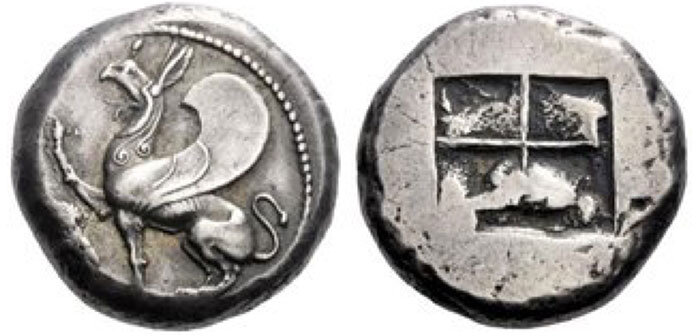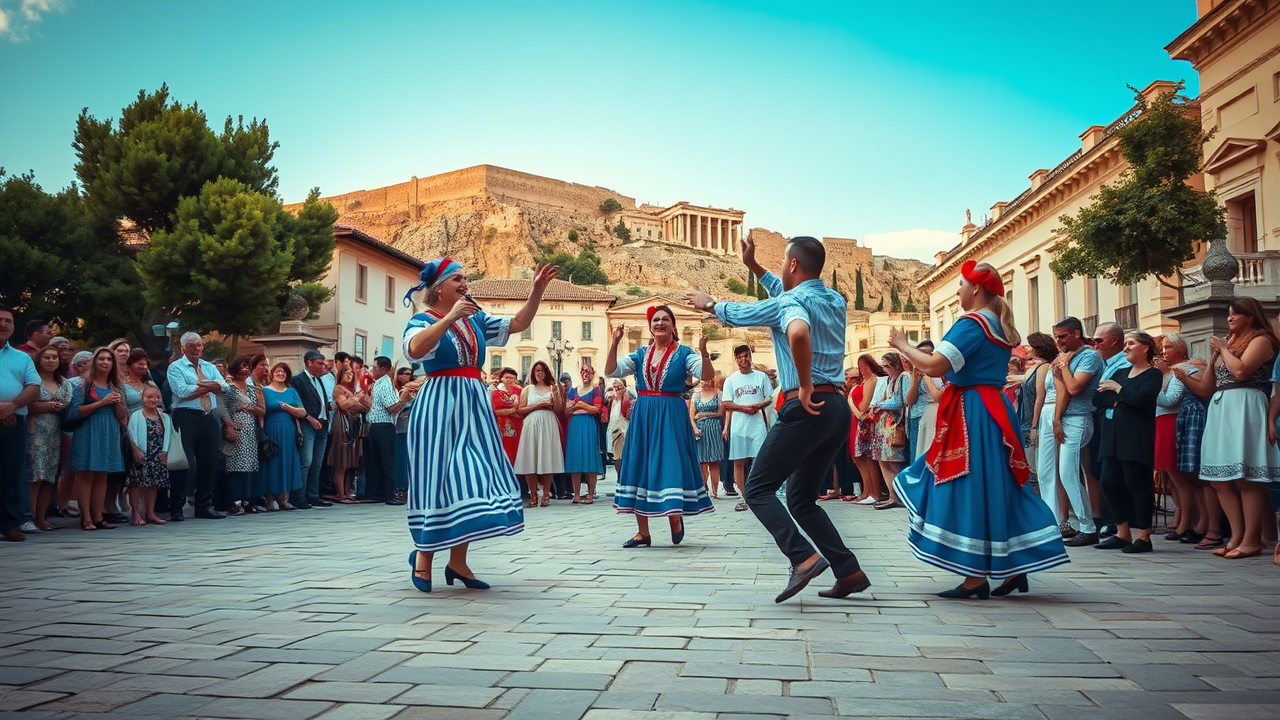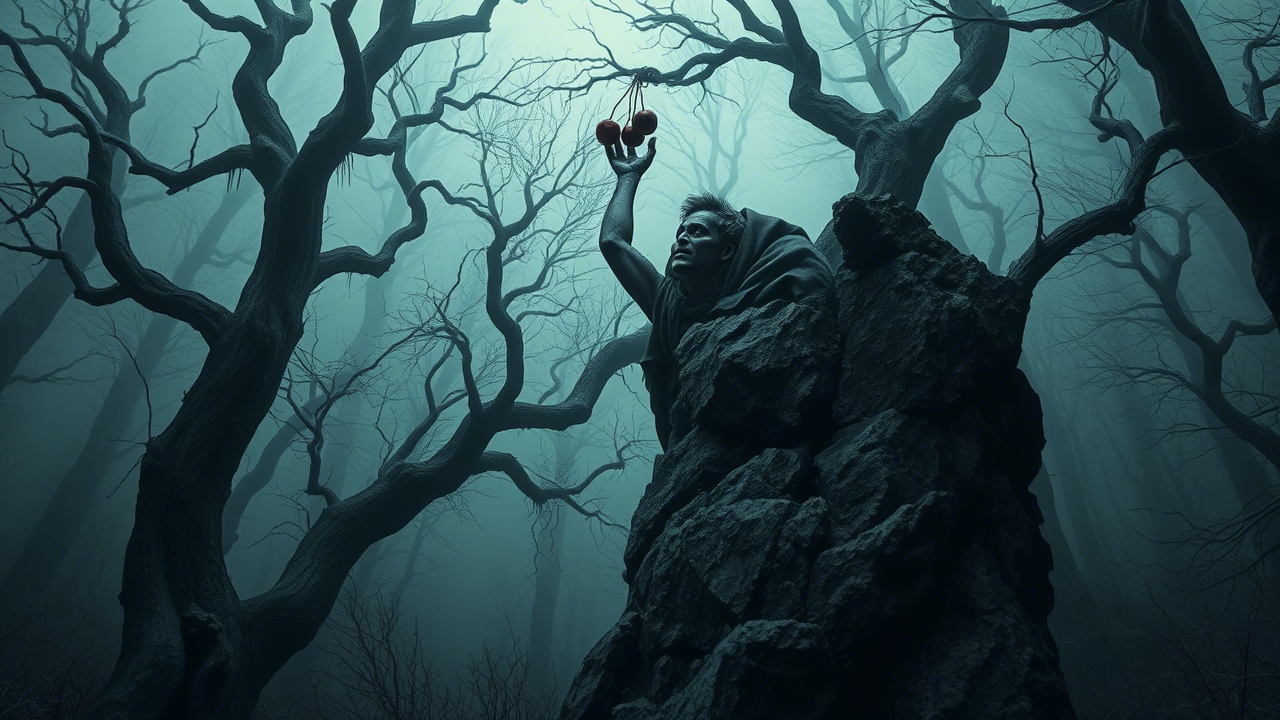Author: Mike Markowitz - coinweek.com
CLASSICAL MYTHOLOGY IS FILLED with monsters. For the civilizations of the ancient Mediterranean, stories of these beasts strongly influenced art, literature and culture – so it is not surprising that mythical monsters appear on coins. As fearsome protectors or the vanquished victims of heroes, monsters provided powerful visual symbols for artisans who engraved coins and rulers they served.
The Minotaur
Consider the Minotaur, who appears on coins from Knossos on the Greek island of Crete.
CRETE, Knossos. Stater (11.93g). about 425 – 360 BCE Vs .: Naked Minotaur in knee walking pattern right. Rev .: Swastika-like labyrinth with five points in the middle. A square recess in each of the four gussets. The undertype is probably a stater from Aegina. Svoronos, Crete 1 Plate. 4. 23 = BMC 1 Plate IV 7 = Le Rider, Crete S.99 No. 2 Plate. 24. 25 (very similar). Gorny & Mosch Auction 224. 13 October 2014. Lot: 816. Realized: 55,000 EUR (approx. 69,744 USD).
Product of an unnatural union between Queen Pasiphaë and a magnificent white bull, the Minotaur was a ferocious man-eating beast, imprisoned in the Labyrinth (a vast maze designed by the brilliant engineer Daedalus). The hero Theseus slew the Minotaur, saving Athenians who were sacrificed to his cannibal appetite every year.
A rare silver stater of Knossos[1] (c. 425 – 360 BCE, about 20 examples known) depicts a running Minotaur, with the head of a bull and the body of a man. A stylized Labyrinth appears on the reverse. On Harlan Berk’s list of 100 Greatest Ancient Coins, this coin is #48. “Appropriately, the depiction is forceful and strong rather than delicate or elegant (34).”
The Hydra
Herakles (better known by his Latin name, Hercules) was the champion monster-slayer of classical mythology. In a fit of madness, Herakles killed his family; to atone for this crime he undertook a series of heroic quests. These “Labors of Herakles” were a favorite theme of Greco-Roman art. The Lernaean Hydra, a many-headed swamp monster, terrorized a marshy lake[2] near the Greek city of Argos.
Sever one of the Hydra’s heads and two immediately grew back, making the monster hard to kill. Herakles slew the Hydra, helped by his companion Iolaus, who cauterized the neck with a torch as each head was cut off.
Crete, Phaistos AR Stater. Mid-Late 4th century BCE. Herakles standing in fighting attitude to right, wearing Nemean lion skin, seizing with his left hand one of the heads of the Lernean Hydra, and with his right hand preparing to strike with club; by right foot, crab on exergual line / ΦΑΙΣΤΙΩ, Bull butting to right on wavy exergual line. Cf. Svoronos 66, pl. 24, 22. 11.47g, 28mm, 7h. Roma Numismatics Ltd Auction XI . 7 April 2016. Lot : 290. Realized: 44,000 GBP (approx. 62,016 USD).
The obverse of a silver stater[3] of Phaistos on Crete shows Herakles fighting the Hydra.
About six centuries later, the same image appears on a magnificent Roman gold aureus of Maximian: “Hercules standing left, battling the Lernaean Hydra, club in upraised right hand and preparing to strike one of the hydra’s heads, another head grasped with his left hand, its serpentine body wrapped about his right leg[4].” Ancient artists consistently show the hero swinging his signature weapon, the club, where one might expect to see him wielding a sword.
Maximian, First Reign (286-310 CE). AV aureus (18mm, 5.59 gm, 6h). NGC Choice MS 5/5 – 4/5, Fine Style. Rome, 293-294 CE. MAXIMIA-NVS P F AVG, head Maximian right, wearing lion skin headdress, paws tied before neck / HERCVLI-DEBELLAT, Hercules standing left, battling the Lernaean Hydra, club in upraised right hand and preparing to strike one of the hydra’s heads, another head grasped with his left hand, its serpentine body wrapped about his right leg; PROM in exergue. RIC – (unknown at the time of publication). Calicó 4661. Heritage World Coin Auctions. NYINC Signature Sale 3071. 6 January 2019. Lot: 32240. Realized: 65,000 USD.
Silver medal 1914, by Eue and Grünthal. For General Erich von Ludendorff. Portrait in Uniform half right/ Naked warrior fighting against Hydra. Zetzmann 4063. 34.5 mm, 18.11 g. WAG Online Auction 66. 3 July 2016. Lot: 1480. Realized: 75 EUR approx. 84 USD.
The heroic struggle against the Hydra has inspired many modern medalists, for example on the reverse of a 1914 silver medal honoring German general Eric von Ludendorff[5].
The Chimera
SIKYONIA, Sikyon. Circa 335-330 BCE. AR Drachm (20mm, 5.80 g, 11h). Chimaira standing left, raising right forepaw; ΣI below / Dove flying left; I below neck; all within olive wreath with ties to right. BCD Peloponnesos 232 (this coin); HGC 5, 209; BMC 109–10; Jameson 2301 (same obv. die); McClean 6253 (same dies). VF From the RH Collection. Ex BCD Collection (LHS 96, 8 May 2006), lot 232. Classical Numismatic Group Triton XVIII. 6 January 2015. Lot: 542. Realized: 850 USD.
Yet the Hydra was the mother of the Chimaera whose breath was irresistible fire. This creature, huge and terrible, swift-footed and strong, had three heads, one of a lion with glaring eyes, one of a goat, and one of a fierce dragon-snake (62).
—Hesiod (c. 750 – 650 BCE)
The hero Bellerophon, riding the magical flying horse Pegasus, killed the fire-breathing Chimaera (or Chimaira) with a block of lead impaled on a spear he lodged in the beast’s throat. The fire melted the lead, choking the beast.
The Greek city of Sicyon, near Corinth (Bellerophon’s home town) adopted the chimaera as a symbol on coins, which are relatively common, from c. 430 down to about 280 BCE[6]. The Chimaera of Arezzo (c. 400 BCE), an Etruscan bronze statue now in the Museo Archaeologico Nazionale in Florence, is probably the most famous classical representation of this monster[7].
Cerberus
In J.K. Rowling’s novel, Harry Potter and the Sorcerer’s Stone (1998), Cerberus appears under the name of “Fluffy”.
Mysia, Kyzikos EL Stater. Circa 500-450 BCE. Cerberus standing to left on tunny fish / Quadripartite incuse square. Von Fritze 10; Boston 1538. 15.90g, 19mm. Roma Numismatics Auction XII. 29 September 2016. Lot : 289. Realized: 18,000 GBP approx. 23,368 USD
In classical mythology, Cerberus (or Kerberos) is a giant, ferocious three-headed dog who guards the gateway to the land of the dead. He is often depicted as the companion of Hades (or Pluto,) god of the underworld. As his 12th Labor, Herakles used his superhuman strength to wrestle Cerberus into submission and drag him back to the land of the living. He then returned to the underworld, unharmed. Cerberus appears on a magnificent electrum stater of Cyzicus (c. 500-450 BCE).
The cataloguer writes:
“For practical reasons, representations of Cerberus in Greek art often depict him with two visible heads (the third being assumed to be hidden), but occasionally three heads, and rarely only one, are also seen[8].”
Under Roman rule, during the reign of Emperor Antoninus Pius (138-161 CE), Alexandria issued a series of large (35 mm, 22.3 grams) bronze drachms illustrating the labors of Hercules. On Berk’s list of the 100 Greatest Ancients, this series is #96 (Berk, 105). The coin showing the capture of Cerberus is very rare. An example form the famous Dattari collection, one of the finest known, brought $8,000 in a 2018 auction[9].
Medusa
Mysia, Kyzikos EL Stater. Circa 500-450 BCE. Facing gorgoneion with mouth open and tongue protruding, six serpents on top of head, another below each ear; below, tunny fish to left / Quadripartite incuse square. Von Fritze 129, pl. IV, 15; Boston MFA 1445 = Warren 1492. Roma Numismatics Auction XVII. 28 March 2019. Lot: 486. Realized: 19,000 GBP (approx. 25,066 USD).
Three mythical sisters, Medusa, Stheno and Euryale, known as the Gorgons, had writhing, venomous snakes for hair, so horrible that the sight of them turned people to stone. Using a mirror-like shield, to avoid gazing directly on the petrifying sight, the hero Perseus beheaded Medusa, presenting the trophy head to the goddess Athena, who affixed it to her own shield.
The image of Medusa’s facing head, the gorgoneion[10] became a very popular symbol in classical art, particularly on coins. An electrum stater of Cyzicus (c. 500-450 BCE) is a good example[11]. At least 37 different ancient cities placed the Medusa head on their coins, including the Etruscan town of Populonia[12]. To modern viewers the grotesque face with protruding tongue is comical, but ancient people probably perceived it differently. A late Hellenistic or Roman gorgoneion, without the grotesque expression, is the logo of the modern Italian fashion house Versace.
The Griffin
IONIA. Teos. Circa 510/05-495/90 BCE. Stater (Silver, 21 mm, 11.98 g). Griffin, with open jaws and two curved tendrils falling down his neck, seated to right, his left forepaw raised; before, grape cluser and leaf. Rev. Quadripartite incuse square. Balcer 15 (A15/P27). SNG Lockett 2851 (same dies). A boldly struck coin with a griffin of splendid style. Leu Numismatik Auction 4. 25 May 2019. Lot: 269. Realized: 5,000 CHF approx. 4,968 USD.
In classical art, griffins have the body of a lion and the head and wings of an eagle, with long ears and a knob like a giraffe’s horn on top of their heads. Seated griffins were often depicted guarding treasures and tombs.
Teos, one of 12 cities in the Ionian League, adopted the griffin as its emblem, as shown on an archaic silver stater[13] (c. 520 BCE). After the Persian empire occupied Ionia, many citizens of Teos relocated to Abdera in Thrace, bringing the griffin emblem along with them. A magnificent silver octodrachm of Abdera (c. 490 BCE) from the famous Hunt collection brought almost $40,000 in a 2015 Swiss auction[14].
Thrace, Abdera Octodrachm circa 490, AR 29.94 g. Griffin seated l. with r. forepaw raised; to l., cluster of grapes (partially out of flan). Rev. Quadripartite incuse square. May period II, group XXII, cf. 42-43. Asyut 137 (this reverse die). Hurter-Pászthory, Studies Mildenberg, p. 113, 2 (this coin). Very rare and in exceptional condition for the issue. Of magnificent. Archaic style and with a superb old cabinet tone. Extremely fine. Ex Sotheby’s sale 19 June 1990, Hunt part I, 60. From the Antilibanon hoard (CH VI, 4-5). Numismatica Ars Classica Auction 88. 8 October 2015. Lot: 387. Realized: 38,000 CHF (approx. 39,297 USD).
The folklorist and historian Adrienne Mayor has proposed a controversial theory that griffin legends are based on fossils of beaked dinosaurs (such as Protoceratops[15]) found in Central Asia by ancient gold prospectors.
Skylla
Ancient sources disagree on the appearance of the monster Skylla (or Scylla). An early account is in Book 12, lines 85-92, of Homer’s Odyssey (c. 700 BCE):
In that cavern lives Skylla, whose howling is terror…
She has twelve feet, and all of them wave in the air, she has six
necks upon her, grown to great length and upon each neck
there is a horrible head, with teeth in it , set in three rows
close together and stiff, full of black death…
SICILY, Akragas. Circa 414-413 BCE. AR Tetradrachm (17.25 gm, 5h). A-K-R-A-G around a pair of eagles standing right on the upturned body of a dead hare; the nearer eagle, with closed wings, screaming with its head reared and beak wide open; the further, flapping its wings and lowering its head to tear at the prey / AKRA-G-A-NTIN-[ON] around a crab with open claws seen from above; below, Skylla swimming left, her right hand raised to shade her eyes, left arm trailing behind, and her hair streaming in the wind. Classical Numismatic Group Triton VIII. 11 January 2005. Lot: 56. Realized: 240,000 USD.
The prosperous city of Akragas on the southern coast of Sicily created some of the most beautiful ancient coins, treasured by modern collectors. The reverse of a silver tetradrachm (c. 413 BCE) pairs the city’s emblematic crab with a depiction of Skylla[16].
She is rendered in a perfectly mastered three-quarter view with her head in profile. In her half-human form she is pictured as a beautiful young woman, naked to the waist, where the foreparts of two dogs are attached. The lower part of her body is transformed into a long, coiled fish tail with sharp-edged dorsal fins and a broad, thorny tailfin. Her wet hair flutters out freely from her head and she lifts her right hand towards her eyes. The first die (R1) is of outstanding artistic quality and is one of the great masterpieces of Greek coinage. The crucial point in the rendering of the strange creature, the transition between Skylla’s human body and the dogs and fish tail, is accomplished in a masterful way (Westermark, 106).
On Berk’s list of the 100 Greatest Ancient Coins, this type is #21 (Berk, 39).
A somewhat different (and more affordable!) representation of Skylla appears on a silver denarius of Sextus Pompey[17] during his era’s Roman Civil War (40 – 39 BCE). Younger son of Pompey “the Great”, Julius Caesar’s onetime ally and later adversary, Sextus gained control of Sicily and continued a doomed struggle against Octavian, Caesar’s heir, until captured and executed in 35 BCE. On the coin’s reverse, Skylla appears as a woman with two sinuous fish tails and three dog heads emerging from her waist. She swings a ship’s rudder above her head as a weapon.
The Hippocamp
PHOENICIA, Byblos (Gebal). ‘Urimilk III. Circa 365-350 BCE. AR Shekel (25.5mm, 13.25 g, 3h). Three hoplites, holding shields, on galley left above waves, prow ending in lion’s head; below, hippocamp left above murex shell, ‘K (in Phoenician) above dorsal fin / Lion attacking bull left; ‘WRMLK MLK GBL (‘Urimilk, king of Gebal in Phoenician) above. E&E-B Series IV.3.1, 775–814 (O2/R2); Rouvier –; Betlyon 18; HGC 10, 136; Kraay & Hirmer 685 (same dies). Classical Numismatic Group Triton XX. 10 January 2017. Lot: 355. Realized: 2,750 USD.
With the head of a horse and the tail of a fish, the winged hippocamp (or hippokampos) was often harnessed to the chariots of sea gods. A hippocamp appears on coins of the Phoenician city of Byblos, accompanying a warship[18].
Modern coins sometimes use a hippocamp as a nautical symbol. On the classic 1915 gold quarter-eagle issued to commemorate the Panama-Pacific Exposition in San Francisco, a graceful maiden (“Columbia”, the female personification of America) reclines on the back of a hippocamp[19].
Centaurs
Centaurs are compound beasts with the head and torso of a man and the hindquarters of a horse. There is deep ambivalence about centaurs in classic mythology. On one hand, they are wise and noble, serving as tutors and guardians of young heroes. On the other hand, they can be savage and hostile.
Gallienus. 253-268 CE. AR Antoninianus (20mm, 3.35 g, 1h). “Animal/ Mythical series” issue. Rome mint, 8th officina. 10th emission, 267-268 CE. Radiate head right / Centaur walking left, holding globe and trophy; H. RIC V 164; MIR 36, 738b; RSC 73. Green and brown surfaces. Good VF. Classical Numismatic Group Electronic Auction 456. 13 November 2019. Lot: 449. Realized: 130 USD.
One of the most celebrated works of Greek sculpture is the “Centauromachy”[20], a series of panels carved (c. 447-442 BCE) for the Parthenon in Athens, depicting a legendary fight between men and drunken centaurs.
A centaur occupies a place in the sky, as the sign of Sagittarius in the zodiac. The most famous centaur was Chiron[21], who tutored Herakles, Achilles, Jason, Perseus, and other heroes. Chiron appears on the bronze trichalkon (second century BCE) of Magnetes in Thessaly, holding a branch over his shoulder[22].
Centuries later, a crudely rendered centaur appears on coins of the Roman emperor Gallienus (ruled 253-268 CE) as part of a long series depicting animals and mythical creatures[23].
Source: coinweek.com




















